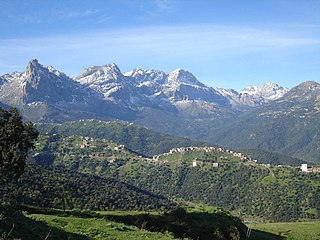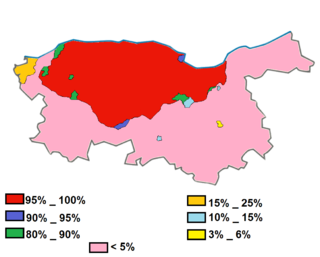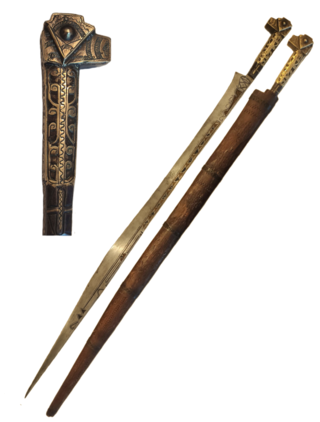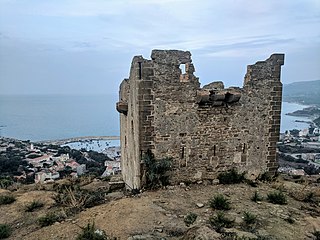
Algerian music is virtually synonymous with Raï among foreigners; the musical genre has achieved great popularity in France, Spain and other parts of Europe. For several centuries, Algerian music was dominated by styles inherited from Al-Andalus, eventually forming a unique North African twist on these poetic forms. Algerian music came to include suites called nuubaat. Later derivatives include rabaab and hawzii.

Kabylia or Kabylie is a mountainous coastal region in northern Algeria and the homeland of the Kabyle people. It is part of the Tell Atlas mountain range and is located at the edge of the Mediterranean Sea.

The Algerian nuthatch or Kabyle nuthatch is a species of bird in the nuthatch family Sittidae. It is a medium-sized nuthatch, measuring between 11.5 cm (4.5 in) and 12.5 cm (4.9 in). The upperparts are bluish-grey. The male can be distinguished from the female by the black front of its crown. The species is sedentary; it feeds on arthropods in summer and on seeds in winter. The breeding season takes place around May–June. The nest, built in a hole of tree, shelters a laying of three or four eggs, brooded by the female. The chicks are fed by both parents.

Kabyle or Kabylian is a Berber language (tamazight) spoken by the Kabyle people in the north and northeast of Algeria. It is spoken primarily in Kabylia, east of the capital Algiers and in Algiers itself, but also by various groups near Blida, such as the Beni Salah and Beni Bou Yaqob.
Berber music refers to the musical traditions of the Berbers, a diverse grouping of distinct ethnic groups indigenous to North Africa who predate the arrival of Arabs in the Arab migration to the Maghreb. Their main connections are identified by their usage of the mostly mutually unintelligible Berber languages. Berber music varies widely across North Africa. It is stylistically diverse, with songs being predominantly African rhythms and a stock of oral literature.

Berberism is a Berber ethnonationalist movement, that started mainly in Kabylia (Algeria) and Morocco during the French colonial era with the Kabyle myth and was largely driven by colonial capitalism and France's divide and conquer policy. The Berberist movement originally manifested itself as anti-Arab racism, Islamophobia, and Francophilia, that was sanctioned and sponsored by French colonial authorities. The movement later spread to other Berber communities in the Maghreb region of North Africa and was facilitated by colonial policies such as the Berber Dahir. The Berberist movement in Algeria and Morocco is in opposition to cultural Arabization, pan-Arabism and Islamism.

Larbaâ Nath Irathen is a town in Tizi Ouzou Province, in the central part of northern Algeria. It was formerly known as Fort National. The population in 2002 was 29,773, The area is renowned for its majestic scenery.

The Berber Spring was a period of political protest and civil activism in 1980, claiming recognition of the Berber identity and language in Algeria, with events mainly taking place in Kabylia and Algiers.

Tizi Ouzou or Thizi Wezzu is a city in north central Algeria, and capital of Tizi Ouzou Province and Tizi Ouzou District. It is among the largest cities in Algeria. It is the second most populous city in the Kabylia region after Béjaïa.

The Kabyle people are a Berber ethnic group indigenous to Kabylia in the north of Algeria, spread across the Atlas Mountains, 160 kilometres (100 mi) east of Algiers. They represent the largest Berber population of Algeria and the second largest in North Africa.

The flyssa, known locally as ajenoui, is a traditional edged weapon of Algeria produced and used during the 19th century and earlier. It originates from the Kabyle Iflissen Lebhar tribal confederacy.

The Black Spring was a series of protests and political demonstrations by Kabyle activists in the Kabylie region of Algeria in 2001, which were met by repressive and violent police measures and became a potent symbol of Kabyle discontent with the national government. The protests took place against a backdrop of long-standing cultural marginalization of the Highlander Kabyle, a homogeneous Berber linguistic group in Algeria despite the most rigid government-sponsored Arabization measures of the 1960s through the 1980s having been lifted. The name "Black Spring" alludes to the events known as the Berber Spring of the 1980s, in which mainly Kabyle civil society activists challenged the ban on Berber culture then in place, demanding cultural rights and democracy.
The Berber Latin alphabet is the version of the Latin alphabet used to write the Berber languages. It was adopted in the 19th century, using varieties of letters.

Beni Mellikeche is a commune in northern Algeria in the Béjaïa Province.
Kabyle grammar is the set of structural rules and regulations included in the Kabyle language, ranging from words to phrases, to punctuation, and sentences.

Beni Ourtilane is a town and commune in Setif Province, Kabylie in north-eastern Algeria.

The Expedition of the Col des Beni Aïcha in May 1837, during the French conquest of Algeria, pitted the troupes coloniales under Colonel Maximilien Joseph Schauenburg against the troops of Beni Aïcha of the Igawawen.

The First Battle of the Issers in May 1837, during the French conquest of Algeria, pitted the troupes coloniales under General Perrégaux and Colonel Schauenburg against the troops of Kabylia of the Igawawen.

The Second Assault of Dellys was an assault by French troupes coloniales under General Thomas Robert Bugeaud (1784–1849) against the Algerian resistance fighters in the town of Dellys, Kabylia of the Igawawen. It was part of the French conquest of Algeria and took place in April–May 1844.















